 Panoramic View of Laramie,
1908, Second Street to left
Compare above scene with Second Street, in the late 1930's, lower left and view on the
on preceding page.
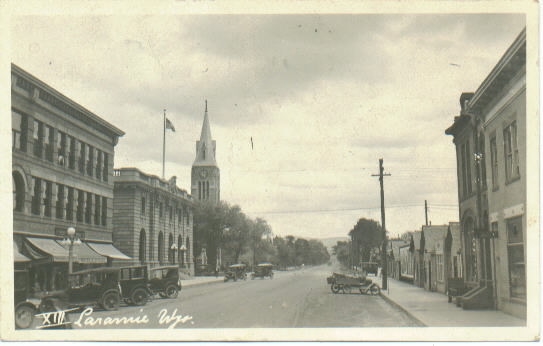
Laramie, approx. 1920
The post office in the above-photo
on the corner of Ivinson and
Third Street is now the site of the First Interstate Bank. Further down the
street is St. Matthew's Episcopal Cathedral constructed in 1896. The above photo as well as the photo of the Connor Hotel
below and that of Grand Avenue on the preceding page appear to have been
taken by Henning Svenson. Svenson came to the United States from Germany in
1903 and joined his brother John Henning in Omaha in 1905. In 1905 he
opened a photography studio in Laramie. In addition to studio photographs he
made a number of photos in the 1920's documenting Laramie and its area.
The studio is still in business, operated by the fourth generation of the
same family. The American Heritage Center at the University of Wyoming maintains
over 20,000 negatives of photographs taken by the family. In addition to
photography, Svenson was a beekeeper, gardener and raised Belgian hares.
In 1905, both the Hotel Johnson on First Steet and the
Kuster Hotel on Thornburg Ave. were opened.
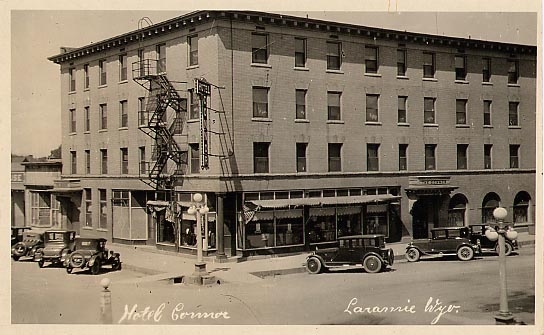
Connor Hotel, 1920
In January 1913, the
Connor Hotel, owned by Mrs.
W. E. Connor,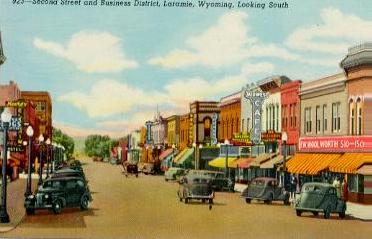 on the corner of Grand Ave. and Third Street opened. The
hotel, once the glory of Laramie, is now utilized primarily for student and former student apartments. In fact, Number One Son
while a student occupied an apartment on the third floor. on the corner of Grand Ave. and Third Street opened. The
hotel, once the glory of Laramie, is now utilized primarily for student and former student apartments. In fact, Number One Son
while a student occupied an apartment on the third floor. The same year the Lincoln Highway
Association, under the auspices of Carl Fisher, of the Prest-O-Lite Company and later developer of Miami Beach, Henry C. Ostermann a promoter
for the Buffalo Bill Wild West Show, and Henry Joy, president of the Packard
Motor Car Company, came to Wyoming and the state saw the beginnings of highways. Each year, in order to promote highways, and incidently sell his
motor cars, Joy would drive a new Packard across the continent. In 1912, Joy literally had to tear down barbed wire fences in order to proceed, but
in 1915 he was able to drive from Detroit to San Francisco in only 21 days.
In contrast, his companion on the trip, Austin Bement, in 1939 was able to drive a new Hupp Skylark
over the same route with a driving time of 59 hours 40 minutes, with an average speed of 46.26 mph.
Bement, then an advertising executive, indicated that the 101 hp. Hupp engine,
"floated us through very high speeds." In 1919, the highway received additional support
from a tour by Lt. Col. Dwight D. Eisenhower who almost 40 years later provided the impetus for the Interstate Highway System.
Fisher lost his fortune in the 1929 Crash and died in poverty suffering from alcoholism in 1939. Joy was
removed as president of Packard and was replaced by the chief engineer. The Packard plant was sold for
for taxes in 1997 and torn down. Ostermann was killed in 1920 when he lost control and overturned his 1918 Packard Twin Six.
Hupp never resumed production following World War II.

University Hall (Old Main) 1908 The Lincoln Highway brought increased traffic
into the state and
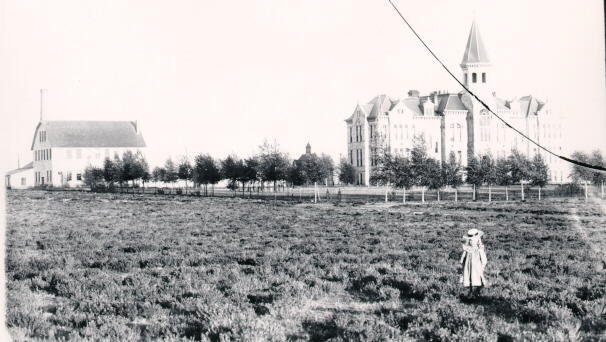 indirectly led to the bringing of the expression "Somewhere
west of Laramie" into the language with Ned Jordan's Saturday Evening Post ad of
June 23, 1923, below right. indirectly led to the bringing of the expression "Somewhere
west of Laramie" into the language with Ned Jordan's Saturday Evening Post ad of
June 23, 1923, below right.  The ad forever changed motor car advertising although the car, itself,
was less than distinctive* and ceased production before the 1929 crash. The text of the ad was regarded as quite daring for the time:
The ad forever changed motor car advertising although the car, itself,
was less than distinctive* and ceased production before the 1929 crash. The text of the ad was regarded as quite daring for the time:
Somewhere West of Laramie
Somewhere west of Laramie there's a bronco-busting, steer-roping girl who knows what I am talking about.
She can tell what a sassy pony that's a cross between greased lightning and the place where it hits, can do
with eleven hundred pounds of steel and action when he's going high, wide and handsome. The Truth is--the Playboy was built for her.The ad was supposedly composed
on a train crossing the Laramie Plains when a girl on a horse racing the train attracted Jordan's attention.
For more pictures of Laramie
from the late 1920's, '30's and '40's see the
Ludwig Collection.Compare the above scenes with present day Ivinson Ave., below, looking East toward the Residence Halls (the tallest buildings
in the state) and 15th Street.
Commencing in 1922 the University began a program of expansion including the construction of a number
of building fronting on the Pasture including Half Acre Gym, Engineering, Arts and Sciences and
Agriculture. 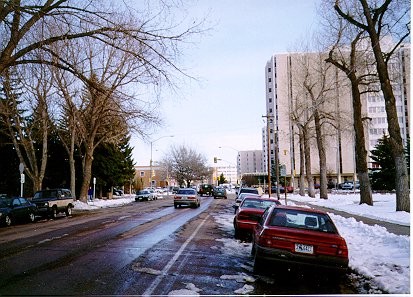
Ivinson Avenue**
Edward Ivinson,1830-1928, a native of the Virgin Islands, as above noted, arrived in Laramie in 1868. The following year, he served on a committee which
brought the territorial prison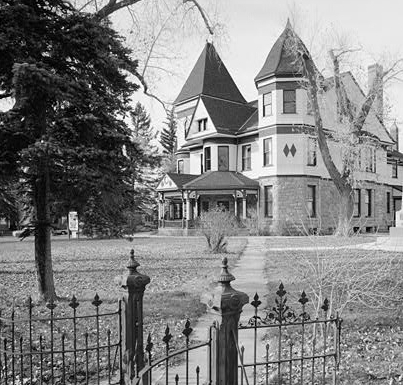 to Laramie and in 1870 purchased the local bank located on the corner of
Third and what is now Ivinson. As a banker he financed the construction of Laramie's first courthouse located on the site
of the present one. In 1892, Ivinson ran for governor, but was defeated by John Eugene Osborne, a Democrat from
Rawlins. Osborne is now more noted as being the one who skinned Big Nose George Parrott, had his hide tanned and turned
into a medical bag and a pair of shoes, see Photos V, which Osborne would wear on special occassions. The rest of Big Nose's remains were kept in a whiskey barrel
in Osborne's medical office until disposed of in a landfill. The shoes are now in the Carbon County Museum. to Laramie and in 1870 purchased the local bank located on the corner of
Third and what is now Ivinson. As a banker he financed the construction of Laramie's first courthouse located on the site
of the present one. In 1892, Ivinson ran for governor, but was defeated by John Eugene Osborne, a Democrat from
Rawlins. Osborne is now more noted as being the one who skinned Big Nose George Parrott, had his hide tanned and turned
into a medical bag and a pair of shoes, see Photos V, which Osborne would wear on special occassions. The rest of Big Nose's remains were kept in a whiskey barrel
in Osborne's medical office until disposed of in a landfill. The shoes are now in the Carbon County Museum.
Ivanson Mansion upper right
Ivinson's contributions to Laramie included money for the first Episcopal Church, the Ivinson
Hospital, and donation of his home to the Episcopal Diocese
which until the 1950's housed a boarding school. It is now
the home of the Laramie Plains Museum, photo above right. Upon his death, he left money for the construction of the
Ivinson Home for Aged Ladies at the corner of 20th and Grand.

* "Wyoming Tale": Alan Simpson may have come to the conclusion
that a "less than distinctive" car may be an advantage. In high school he was a "crack shot" to the
extent that some of his follow students would ask the local radio station to dedicate to Simpson
the country song "There's a hole in my mailbox". One of his friends, however, was not as good a shot and
accidently killed a cow. Simpson and his friends were caught because Simpson was driving his dad's Nash
which was easily recognized. An advantage to a small town is that all cars are
easily recognized. My own kids always wondered how I "knew" when they had been up to
some devilment. Just about everyone in town knew the car. Shooting the mailboxes
is, however, probably no worse than my older son's fraternity, like a scene from "Animal House", shooting bottle rockets
into the Albany County Courthouse or the Laramie P.D. from their homecoming float. Homecoming theme: "Cowboys Conquoring the West".
Float theme: "Cowboys Napalming the West". **Photo and "cracked plate" photo of Old Main from
The Landscape Overheard: Campuses, Conversations, and Cultures at the University of Wyoming.
|